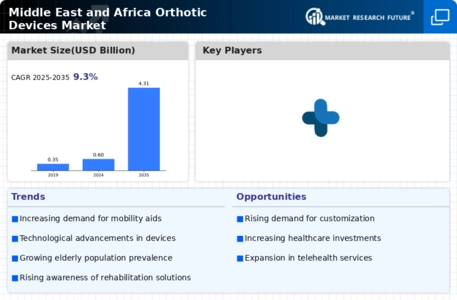Market Growth Projections
The MEA Middle East and Africa Orthotic Devices Market Industry is expected to experience robust growth over the coming years. Projections indicate that the market will expand from 0.6 USD Billion in 2024 to 4.31 USD Billion by 2035, reflecting a significant increase in demand for orthotic solutions. The anticipated CAGR of 19.63% from 2025 to 2035 underscores the potential for innovation and investment in this sector. Stakeholders should closely monitor these trends to capitalize on emerging opportunities within the market.
Growing Awareness of Rehabilitation Solutions
There is a noticeable increase in awareness regarding rehabilitation solutions within the MEA Middle East and Africa Orthotic Devices Market Industry. Educational campaigns and community outreach programs are highlighting the benefits of using orthotic devices for recovery and mobility enhancement. This growing awareness is encouraging patients and healthcare providers to consider orthotic solutions as viable options for treatment. Consequently, the demand for these devices is expected to rise significantly, aligning with the projected market growth trajectory, which anticipates a CAGR of 19.63% from 2025 to 2035.
Rising Prevalence of Musculoskeletal Disorders
The increasing incidence of musculoskeletal disorders in the MEA Middle East and Africa Orthotic Devices Market Industry is a primary driver. Conditions such as arthritis and osteoporosis are becoming more prevalent due to aging populations and lifestyle changes. For instance, the World Health Organization indicates that musculoskeletal disorders affect millions in the region, leading to a growing demand for orthotic devices. This trend is expected to contribute significantly to the market, with projections estimating a market value of 0.6 USD Billion in 2024, potentially reaching 4.31 USD Billion by 2035.
Technological Advancements in Orthotic Devices
Innovations in technology are transforming the MEA Middle East and Africa Orthotic Devices Market Industry. The introduction of smart orthotics, which integrate sensors and data analytics, enhances patient outcomes and compliance. These advancements not only improve the functionality of devices but also cater to the specific needs of users. For example, 3D printing technology is being utilized to create customized orthotic solutions, which are gaining traction in the region. As a result, the market is poised for substantial growth, with a projected CAGR of 19.63% from 2025 to 2035.
Aging Population and Increased Disability Rates
The aging population in the MEA Middle East and Africa Orthotic Devices Market Industry is a crucial factor driving market expansion. As the demographic shifts towards an older population, the prevalence of disabilities and chronic conditions is likely to increase. This demographic trend necessitates the use of orthotic devices to enhance mobility and quality of life for the elderly. With the market projected to grow from 0.6 USD Billion in 2024 to 4.31 USD Billion by 2035, addressing the needs of this demographic will be essential for stakeholders in the orthotic devices sector.
Government Initiatives and Healthcare Investments
Government initiatives aimed at improving healthcare infrastructure in the MEA Middle East and Africa Orthotic Devices Market Industry are fostering market growth. Many countries are increasing their healthcare budgets and investing in rehabilitation services, which include orthotic devices. For instance, initiatives to enhance access to healthcare services for individuals with disabilities are being implemented across various nations. This commitment to improving healthcare access is likely to drive demand for orthotic devices, contributing to the anticipated market growth from 0.6 USD Billion in 2024 to 4.31 USD Billion by 2035.




Leave a Comment